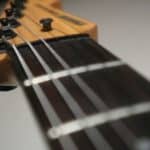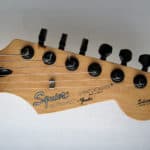Guitars are imperfect instruments by design.
It’s not out of the expectations that certain notes might sound a bit off.
However, when tuning starts getting a bit out of control across the neck, it’s natural that you start worrying.
But fret not! (pun intended)
I’m here to shed some light on what might be causing your instrument to be out of tune on its higher frets.
The most common causes for guitar strings to go out of tune on the higher frets are:
- Old strings
- You are pushing too hard on the strings
- Fretboard wear
- Neck relief
- String length issues
- Grooves in the bridge saddles
- Grooves in the frets
In this article, I will talk about the most common issues that might be causing your guitar to have some intonation troubles, and discuss some alternatives to take on them.
After leaving this page, you will have a better understanding of how intonation works on your instrument, and have some actionable fixes to solve your tuning issues.
Are you ready to get started?
Let’s go!
How to know if your guitar has a tuning issue?
First of all, it’s important to understand that guitars have intonation issues by design.
Notes are not exactly where frets are placed, and this is particularly noticeable in the first frets of the instrument, however, higher frets tend to be a bit better off usually.
If you feel like there’s something off on your guitar, I’d recommend you check the pitch of each of the problematic frets with a tuner, and then compare them with the notes from another sector of the fretboard.
Are the ones from the first group more out of tune than the ones from the second set?
If so, you might have an issue here, but this is still not enough evidence.
Another usual check for the overall intonation of the instrument is checking if the open strings and the strings fretted on the 12th fret ring the same note in different octaves.
If you get deviations from this after performing this test your guitar might require a setup.
After you have performed these checks, the next step would be to identify the specific problem present.
What is intonation on a guitar?
Referring to this particular issue as a “tuning” problem is not quite correct.
You see, your guitar might be tuned properly, but still have problems with some notes.
When this happens, we should refer to it as “intonation” problems.
Intonation refers to the ability of the instrument to provide consistent pitches along its fretboard.
So, in a correctly intonated guitar, if the open strings are perfectly in tune, you should expect that any other fretted note would at maximum be a few cents off.
If you tune your guitar with an electronic tuner, and then you fret the 5th fret and you hear or measure it being a quarter tone off than its intended pitch, well my friend, you have a hell of an intonation problem.
And the first step is figuring out where it may be coming from.
What could cause higher frets to sound out of tune?
Since your issue has to do with higher frets, we can probably discard the nut as being the culprit.
However, there are many other things that could be messing with your tuning by themselves or in conjunction.
Here are some of them:
- Old strings: Guitar strings have a finite lifespan, and when they get rusty and debris attaches to them they start vibrating irregularly along the fretboard.
- You are pushing too hard on the strings: Perhaps you are a heavy-handed player that just digs in a way too much when fretting notes, making them go sharp.
- Fretboard wear: Divots in your fingerboard might be causing you to press the strings too deep into them, pre-bending them and making them sound sharp.
- Neck relief: Too much or too little neck relief might be causing intonation issues.
- String length issues: One or many of your bridge saddles might have moved out of position making the effective string length too long or too short to properly intonate.
- Grooves in the bridge saddles: A worn saddle might be allowing for the string to sink deeper than it should in it, messing with its effective length.
- Grooves in the frets: Worn-out fret wire might develop grooves where strings sink and bend slightly ending up generating intonation issues.
Ways to fix intonation issues on the higher frets
Now that we have pointed out the most common places where things might be not working properly in your guitar it’s time to mention some possible fixes.
Many of these are quite easy jobs that anyone with a bit of handiness could easily perform.
However, if you are not comfortable with working on your guitar, and you are worried about messing it up, by all means, go to your local luthier or guitar tech.
I’m pretty sure he/she will know exactly what to do and how to do it seamlessly.
Now let’s get to it one by one:
- Old strings: Don’t be cheap, get a fresh set.
- You are pushing too hard on the strings: Not much to do here other than learning to play more softly or swapping your strings for higher gauge ones, less prone to bending behind the frets.
- Fretboard wear: Fret divots caused by extreme use can be sanded down and/or filled. This is another fix that requires some skill and might be better to let a luthier do it.
- Neck relief: Your neck might be bent too much or too little, there are plenty of tutorials online for dealing with it, and it mostly takes a few turns on the screw of the truss rod.
- String length issues: If your saddles have moved for any reason, you will need to re-set them in place, this can be done with a screwdriver, a tuner, and lots of patience.
- Grooves in the bridge saddles: If your bridge saddles have developed grooves that mess with your proper string lengths you can just replace them, or move them backward or forward to compensate for the more sunken string.
- Grooves in the frets: Worn-out frets can be recrowned or dressed by a professional. However, maybe a complete refret is due for your guitar at this point.

Hello there, my name is Ramiro and I’ve been playing guitar for almost 20 years. I’m obsessed with everything gear-related and I thought it might be worth sharing it. From guitars, pedals, amps, and synths to studio gear and production tips, I hope you find what I post here useful, and I’ll try my best to keep it entertaining also.





